Что такое ias в war thunder
Обновлено: 05.07.2024
The Ballistic Computer is a system found on some modern aircraft and helicopters used to aid the player in the delivery of unguided air-to-ground munitions. There are two key functions of the ballistic computer: Constantly Computed Impact Point (CCIP) and Constantly Computed Release Point (CCRP). CCIP continually calculates where munitions will land and gives the pilot an accurate impact point to aim with. By comparison, CCRP allows the player to specify an impact point, the ballistic computer will then continually calculate at which point along the player's flight path munitions will need to be released in order to hit the player's designated impact point, automatically releasing the munitions when that point is reached.
Что такое ias в war thunder
Keofox, Как будет выглядеть карта Польша после сброса Фаб-5000 на неё теперь? Висящие в воздухе домики?
Вот вот, а то в тизере какую угодно замануху можно показать.
Очень недурно! Надеюсь мой компьтер не расплавится от этой красоты! Молодцы, за ковши отдельное спасибо!
согласен корж пили это что то.
ох сколько же багов нас ждет. Дома в воздухе, летающие танки, проблемы с коллизией. Ух
Я жду моменты, когда бобры спецом будут обкидывать респы по кругу, чтобы замедлить команду (вражескую естесно) ещё при спавне. Тактика))
oddPixel, И при этом все сидят в лагах и наслаждаются генерацией и загрузкой воронок. Тут сейчас до сих пор от бомб лаги. А теперь. И от арты будет вообще жесть. И интересно кв-2 и другие большие пушки тоже будут воронки делать?
Если механика окапывания хорошо впишется в общий геймплей, то вы - большие молодцы! Но мне почему-то кажется, что это увеличит число кемперов и бодрость геймплея, которая и так не высока, упадёт ещё сильнее.
Особенно хорошо она впишится в геймплей на рангах ниже 6-го, без сомнений коренное изменение геймплея для всей игры.
В игре по сути окапываться будут только СССР и Британцы с АВРЕ
Спасибо за ещё одну крысиную механику, а то ж их так мало было, да?
Новая возможность для тактических манёвров, как и остовы подбитой техники. Разве не круто? А то Destruction Derby на танках, не совсем отражает ход боевых действий
PakoTuHa_61rus, Чел если бы это была стратегия или бои 30 на 30 на огромной карте тогда да тактические, а так это будет только мешать играть всем.
Осталось только ввести расход горючего и его оплату, чтобы встать на горе с заглушенным движком было ещё и по серебру выгодно, и вот тогда совсем хорошо станет!
Визлей заказывали? Получите. Ковшиком теперь можно будет нагрести под НЛД, чтоб не отлетать с одной тычки, особенно на совках? Ничоси у вас технологии. Но главное – воронки теперь похожи на то, чем они должны быть и оттуда реально можно будет от башни играть, нюанс лишь в одном – движок у вас уже, как у A6M5c – еле тянет что уже есть. Но проблема известна, года 3 ещё будем дружно все фризить в боях тунков.
Игровые термины
- Лаг — потеря (задержка) пакетов по пути от сервера к клиенту (или наоборот), либо замедление работы сервера, приводящие к «подвисанию игры» (Не путать с ЛаГГ-3).
- Лакер — везунчик, удачливый.
- Лампочки / Лампы — очки исследований (единицы опыта).
- Лапти — конструктивно не убирающиеся шасси.
- Лвл — уровень игрока, а также ранг техники.
- Ливер (от англ. to leave) — игрок, выходящий в ангар в разгаре боя, и подводящий тем самым свою команду.
- Личка/ЛС — почтовая система, одно из средств общения между игроками.
- Лол — сокращение имеет смысл как «громкий смех».
- Лом — см БОПС
- Лось\Олень — плохой игрок, несмотря на множество боев и хорошую технику.
- Львы — виртуальная валюта, получаемая в самой игре.
- Люстра — устройство для управления обзором путем вращения головы, в фабричном (TrackIR) или самодельном (Freetrack) исполнении. Часто включает в себя крепящиеся к голове светодиоды, отсюда название.
- ЛТХ — лётно-технические характеристики.
CCRP Usage
In addition to CCIP, some aircraft have the option of dropping bombs using CCRP. Using CCRP does not require the ballistic computer to be turned on, however the process is more involved than using CCIP. First, the player must select a target point where they want their bombs to land. This can be achieved in one of two ways; the first is to point your aiming reticle where you want the bombs to land and then press the "Activate target point" key; the other is to press the "Switch mission bombing target" key, this will automatically place the target point on one of the missions "mini-bases" or airfield (press the key multiple times to cycle through available targets). You can place the target point on one pass and then come around for a second pass to drop the bombs (the marker will disappear when your plane is not facing towards it, however will reappear when you point your plane towards it again, the "CCIP/RP" indicator will remain present throughout). Note that while a target point is active you cannot drop bombs manually (CCRP must be used), press the "Deactivate target point" key to remove the target point and restore normal bombing functionality.
Both of the above methods will place a red target point square on the ground and activate CCRP and a "CCIP/RP" indicator will appear next to the ammo count of the player's bombs. More noticeably a vertical white line will appear passing through the target point. This line will have a circle on it, with a horizontal line somewhere above the circle; the circle and line will move up and down as the player's aircraft pitches up and down, and the line will move towards the circle as the player approaches the target point. The player must place their aiming reticle over the circle and then press and hold either the "Drop bomb" or "Drop bomb series" key (depending on if you want to drop one or multiple bombs).
When the key to drop bombs is pressed you will notice that no bombs are dropped, however a set of angled crosshairs appear around the circle on the vertical line, and "Bomb release permission" will appear at the bottom of your screen. You must now continue to hold whichever key you pressed to drop the bombs, while keeping your reticle pointed in the circle. As the circle moves with your pitch you can make pitch (nose of the aircraft up or down) adjustments, however you should take care not to yaw (nose of the aircraft side to side) off of the white line, it is also advisable to avoid rolling the aircraft (keep it as level as possible). As you fly towards the target point the horizontal line will move close to the circle, until the touch, at which point the bombs will automatically be released, and should hit the target point.
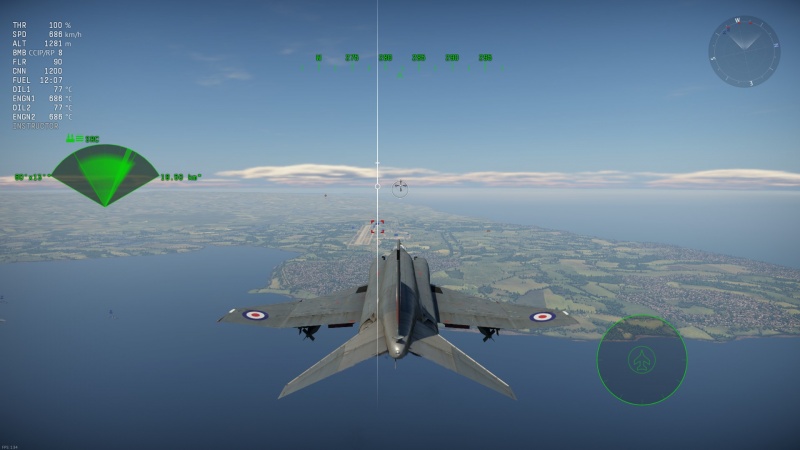
Stage 1: A target point has been selected (placed on some parked vehicles), the "CCIP/RP" indicator is present and the white vertical line has appeared.
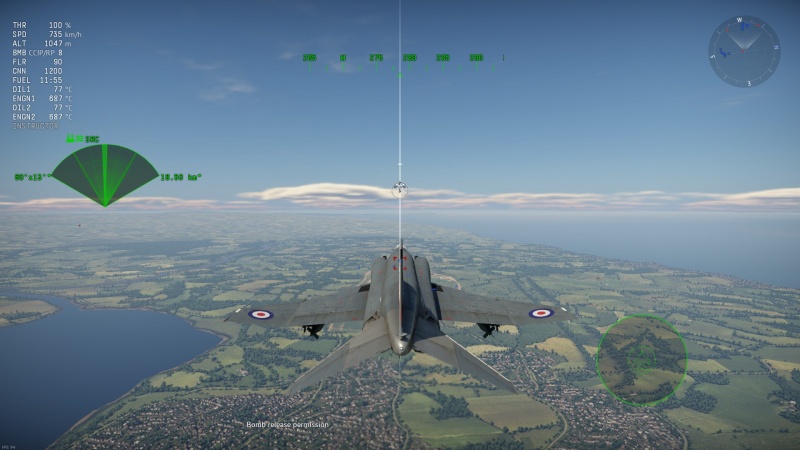
Stage 2: The player has placed their reticle over the circle and is holding the "Drop bomb" key, the crosshairs and "Bomb release permission" text have appeared.
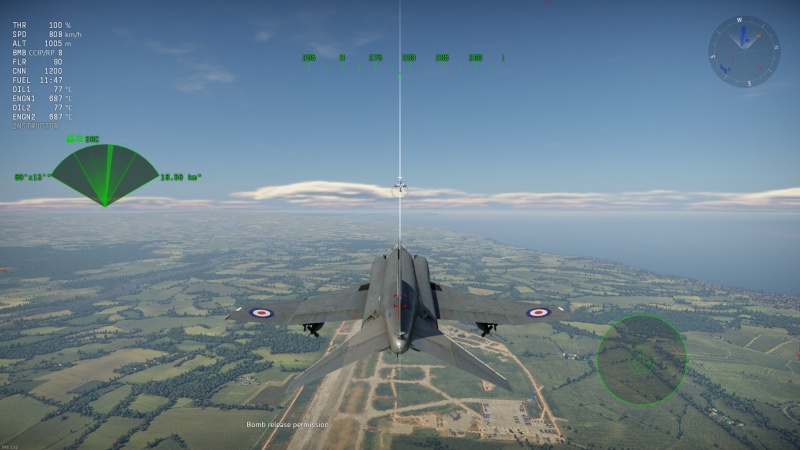
Stage 3: The player has approached the target point and the horizontal line has gotten closer to the circle.
War Thunder исполнилось 7 лет - рассказываем об истории проекта и студии Gaijin Entertainment

В начале ноября 2019 года War Thunder отмечает День Рождения. Игре от российской студии Gaijin Entertainment исполнилось ровно 7 лет. Хороший повод оглянуться назад, чтобы оценить путь, пройденный разработчиками.
Компания была основана в далеком 2002 году и в последующие годы проделала огромную работу, пробуя себя в разных жанрах. Начав с проектов по лицензии, вроде "Бумер: Сорванные башни", "Жмурки” и “Параграф 78”, разработчики постепенно набирались опыта, попутно доводя до ума свой графический движок Dagor Engine.

Жанровые эксперименты (у студии были, гонки, слэшеры, шутеры и приключения) позволили им путем проб и ошибок оценить возможности и в нужный момент сорвать куш благодаря точному удару.
Хотя днем рождения War Thunder и считается 1 ноября 2012 года, стоит признать, что история ведет свой отсчет гораздо раньше. В 2007 году Gaijin официально объявила о том, что она работает над новым проектом в культовой серии авиасимуляторов "Ил-2 Штурмовик", который получит подзаголовок "Крылатые Хищники".
Если команда создателя оригинальной игры "Ил-2 Штурмовик" Олега Медокса напирала на олдскульный реализм, то "гайдзины" начали двигаться в ином направлении, предложив геймерам более доступную игру с гибкой настройкой сложности. Этому способствовало еще и то, что компания решила выпустить "Крылатых Хищников" сначала на Xbox 360 и PS3, где в моде были аркадные симуляторы.
Как показало время, сделанные решения оказались верными. “Ил-2 Штурмовик: Крылатые Хищники” были тепло восприняты критиками (средний рейтинг версии для Xbox 360 в прессе составляет 80.71%) - Gaijin Entertainment смогла занять нишу, в которой была крайне низкая конкуренция. На тот момент серия Ace Combat забуксовала, что играло на руку российским разработчикам. При этом в жанре авиасимов по мотивам Второй мировой войны у "Крылатых Хищников" и близко не было адекватных конкурентов.

Войдя во вкус, Gaijin продолжила окучивать военную тематику, выпустив успешные Apache: Air Assault (симулятор вертолета) для Activision и Birds of Steel для KONAMI. Во второй игре студия продолжила развивать идеи, заложенные в "Крылатых хищниках". Игра избавилась от подзаголовка "Ил-2 Штурмовик" и была посвящена боям в Тихоокеанском регионе.
Несмотря на успех, главным магнум опусом российской студии стала именно War Thunder. Проект был анонсирован в 2011 году под названием World of Planes и изначально должен был стать многопользовательским авиасимулятором. Для анонса был выбран подходящий момент, так как ниша еще только осваивалась конкурентами.
Но амбиции российских разработчиков выходили за рамки простых воздушных сражений: они хотели сделать масштабный симулятор боевых действий, которые будут происходить не только в небе, но и на суше и в воде. Именно поэтому игру быстро переименовали в War Thunder.
Проект был запущен в стадии открытой беты 1 ноября 2012 года и был благосклонно воспринят как критиками, так и игроками. Средний рейтинг игры составляет 80%. Студия продолжила переосмыслять подход к жанру, поэтому проект нельзя назвать в полной мере ни аркадным, ни симуляционным. Привлекая широкую аудиторию, компания упростила управление, но вместе с тем сохранила элементы хардкора, которые выражены в отсутствии банальной линейки здоровья и других характеристиках. Также имелось несколько уровней реалистичности (по сути, сложности), что позволило распределить игроков по сферам интересов.
Разработчики серьезно потрудились над физикой, поэтому самолеты имеют множество различных характеристик. Учитываются такие параметры, как материалы, из которых изготовлена техника, точность попадания, типы снарядов, характеристики орудий и многое другое.
Все это позволило заинтересовать и хардкорную аудиторию, которая интересуется военной историей. Вокруг War Thunder сформировалось сплоченное комьюнити, послужившее плацдармом для реализации наполеоновских планов "гайдзинов".
Следующим важным моментом в развитии игры стал 2014 год, когда произошло сразу два события. Во-первых, в мае вышло из закрытой беты дополнение, добавляющее долгожданную наземную технику, что открыло новый этап жизни проекта.
Вторым не менее знаменательным событием стал релиз War Thunder на новой консоли PlayStation 4. Ключевой особенностью стал кроссплатформенный мультиплеер, в котором игроки на PC смогли в битве с консольными оппонентами выяснить, кто лучше владеет геймпадами или мышками с клавиатурой. В 2018 году к этой грандиозной баталии присоединились и обладатели Xbox One.

Постепенно игра обрастала различными механиками, уникальными игровыми режимами и новой техникой. Так, в 2016 году появились противотанковые управляемые ракеты. А благодаря модернизации движка Dagor Engine War Thunder стала еще красивее.
Летом того же года состоялся анонс морской части игры. Gaijin Entertainment поступила довольно нестандартно: вместо больших и очень медленных военных кораблей студия сконцентрировалась на малом флоте из катеров, из-за чего не пострадала динамика игры и реалистичность. Правда, открытое бета-тестирование стартовало только в 2018 году, что было связано с той огромной работой, которую необходимо было проделать сотрудникам компании.
“Гайдзины" занимались не только покорением стихий: компания смотрела в будущее. Для этого было решено сделать ход конем. В 2017 году было объявлено о том, что в War Thunder появится современная техника, включая не только танки, но и вертолеты. Опыт работы над Apache: Air Assault не прошел даром. Обещания были реализованы весной-летом 2018 года, что ознаменовало новый этап в развитии проекта.
Крайне плодотворным выдался и 2019 год: появились тяжёлые крейсера и эсминцы, а также тепловизоры и приборы ночного видения. К тому же программисты продолжают дорабатывать графический и звуковые движки, делая игру более зрелищной.
Несмотря на то, что проекту исполняется семь лет, Gaijin Entertainment намерена не снижать темп и постоянно радовать своих поклонников. Студии есть, чем гордиться: сложно найти игру, которая предлагает опробовать в масштабных сражениях порядка 1500 единиц военной техники из разных временных периодов и разных родов войск, разделенных на восемь стран: СССР, Китай, Франция, Германия, Япония, Италия, Великобритания и США.
Компанию не интересуют мифические прототипы: в игре только реально существовавшие экземпляры, которые родились благодаря усилиям гениальных инженеров и возможностям ВПК. Поблажки разрешаются только на ивентах, приуроченных к 1 апреля и Хэллоуину, где могут встречаться гигантские боевые улитки и прочие приколы.
Совокупность вышеобозначенных факторов позволяет назвать War Thunder просветительским проектом. Разработчики прекрасно это осознают и помогают реализовать различные культурные инициативы. Так, студия и игроки собрали порядка пяти миллионов долларов на финансирование фильма "28 панфиловцев", увидевшего свет в 2016 году.
Кроме того, Gaijin остается крупнейшим в России независимым разработчиком игр для ПК и консолей. Будет интересно узнать, что нового компания приготовила для консолей следующего поколения. А пока, с Днем Рождения, War Thunder, универсальный симулятор боевой техники XX века!
Air Speed
True Air Speed can be displayed by selecting 'No' for 'Indicated air speed' under the Interface tab of Game Options. It will then be shown in the HUD as 'SPD'.
TAS is useful for navigation as it accurately represents your true speed (relative to wind) and is corrected for effects of altitude. It can however be misleading, and IAS is more useful for maneuvers because it is the speed that is directly indicated by the aircraft ( the IAS "indicated airspeed").
Ground Speed It should be noted TAS isn't the same as Ground Speed as it's still an air speed, relative to the air the plane is travelling in. This means it's affected by the strength and direction of the wind.
- If there is no wind (relative to the direction of travel) TAS and GS are equivalent
- If in a tailwind, GS is the sum of TAS and wind speed
- If in a headwind, GS is the TAS minus wind speed
(Note that different types of planes have different speed don't fly a bomber near the ground you will never gain enough altitude)
Indicated Air Speed can be displayed by selecting 'Yes' for 'Indicated air speed' under the Interface tab of Game Options. It will then be shown in the HUD as 'IAS'.
Essentially IAS readings becomes lower with altitude because of the thinning of air at higher altitude.
How IAS is calculated [ ]
alone. If you know the air density, you can calculate the air speed. This is where IAS and TAS differ.
At higher altitudes air gets thinner, this change in air density affects the IAS reading. IAS and TAS are identical at sea level and as you get higher due to the thinner air the IAS reading gets lower compared to TAS with altitude.
Why IAS is better for maneuvers [ ]
, what you'll notice is that the dynamic pressure shown above is also a part of this lift equation. What this means is that although IAS is an incorrect air speed reading, it's still correct relative to the dynamic pressure, which affects lift in the same way as the air speed indicator.
Essentially what this means is that while a plane at 200 TAS at high altitude will not fly as well as a plane at 200 TAS at sea level due to the thinner air, a plane flying 200 IAS will fly the same at all altitudes since the lack of air density is corrected for by a higher speed if you maintain your IAS.
Calibrated Air Speed is IAS after correction for instrument error, the shape of the plane, location of the pitot tube and high speeds can affect the airflow resulting in flawed readings from the air speed indicator (position error). Since War Thunder isn't an aerodynamics simulator it can be assumed IAS readings shown are 'correct' CAS readings and no corrections are necessary.
Calibration tables are usually provided to pilots so they can convert from IAS to CAS as necessary depending on their wing configuration. This table is specific to each airplane.
CCIP Usage
CCIP for guns
To use CCIP for guns you must first turn on your ballistic computer using the "Toggle Ballistic Computer" control, when you do this a "CCIP" indicator will appear next to the ammo count of the weapon(s) which CCIP is active for (see images below). For aircraft, once the ballistics computer is on pointing your aiming reticle at a point on the ground (up to around 2.6 km away) will activate CCIP. When CCIP is activated the aiming reticle will gain a second set of angled crosshairs (signifying CCIP is active) and move to the point on the ground where your rounds will land; this can be seen in the images below, notice how the reticle has moved downwards and gained an additional set of angled crosshairs.
For helicopters activating CCIP for guns will cause the gun reticle to gain the additional angled crosshairs. For helicopters with turreted weapons, CCIP makes no real difference as the gun reticle behaves pretty much like CCIP by default, however for helicopters with fixed guns CCIP behaves much the same as with aircraft, albeit with greater range.
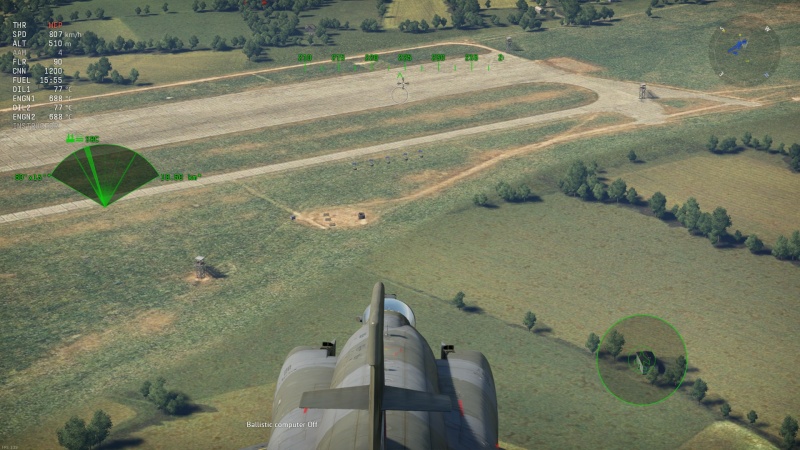
The normal gun reticle on a Phantom FGR.2.
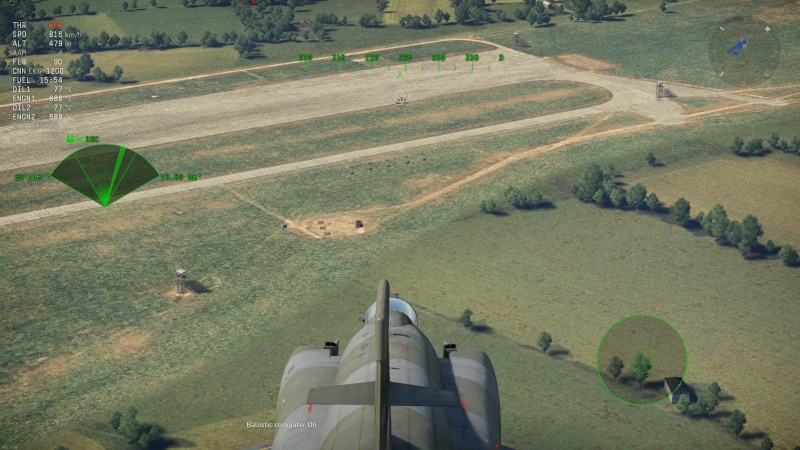
The CCIP gun reticle on a Phantom FGR.2.
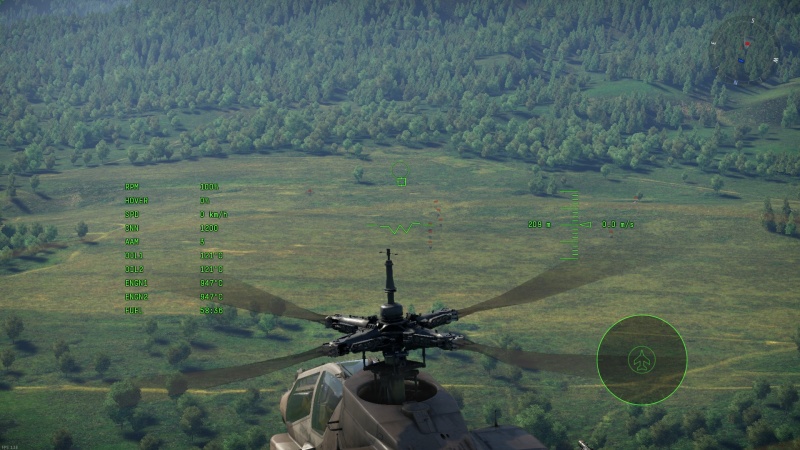
The normal gun reticle on an AH-64A Peten.
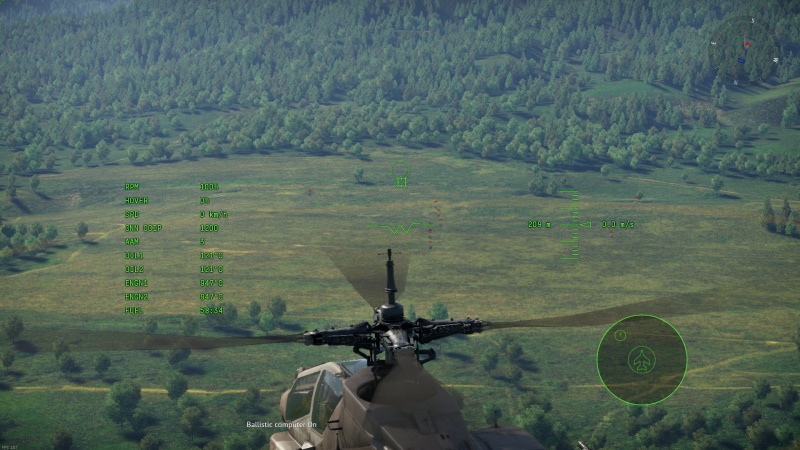
The CCIP gun reticle on an AH-64A Peten.
CCIP for rockets
To use CCIP for rockets you must first turn on your ballistic computer using the "Toggle Ballistic Computer" control, when you do this a "CCIP" indicator will appear next to the ammo count of the weapon(s) which CCIP is active for (see images below). For aircraft, once the ballistics computer is on pointing your aiming reticle at a point on the ground (up to around 5.2 km away) will activate CCIP. When CCIP is activated your rocket reticle will change to an "X" with a dot in the middle and move to the point on the ground where your rockets will land; this can be seen in the images below, notice how the reticle has moved and changed to an "X".
For helicopters activating CCIP for rockets will cause the rocket reticle to gain a set of angled crosshairs and move to the point on the ground where your rockets will land; this can be seen in the images below, notice how the reticle has moved downwards and gained an additional set of angled crosshairs.
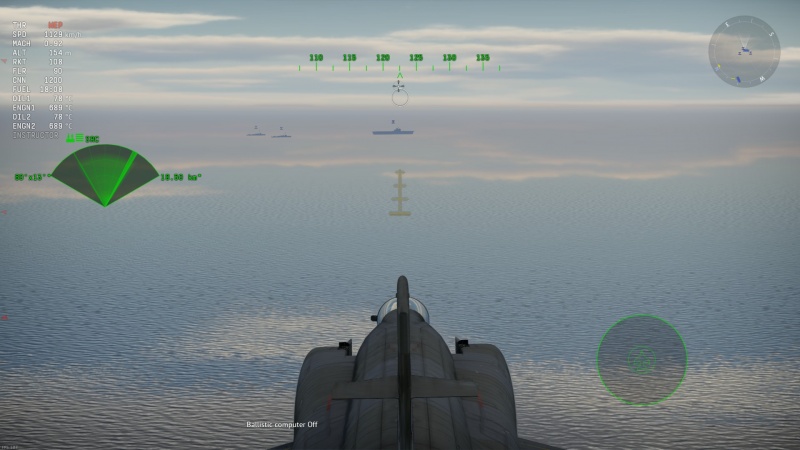
The normal rocket reticle on a Phantom FGR.2.

The CCIP rocket reticle on a Phantom FGR.2.

The normal rocket reticle on an AH-64A Peten.
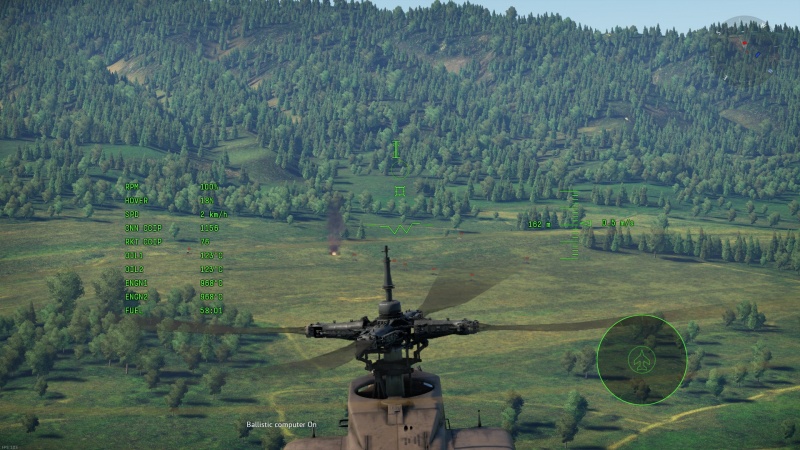
The CCIP rocket reticle on an AH-64A Peten.
CCIP for bombs
CCIP for bombs is always activated for vehicles which have it (regardless of if the ballistic computer is turned on). Aircraft with CCIP for bombs will have a "CCIP" indicator next to the ammo count for the player's bombs. It simply provides an "arcade-style" bombsight on the ground to accurately tell the player where their bombs will land; as seen in the images below.
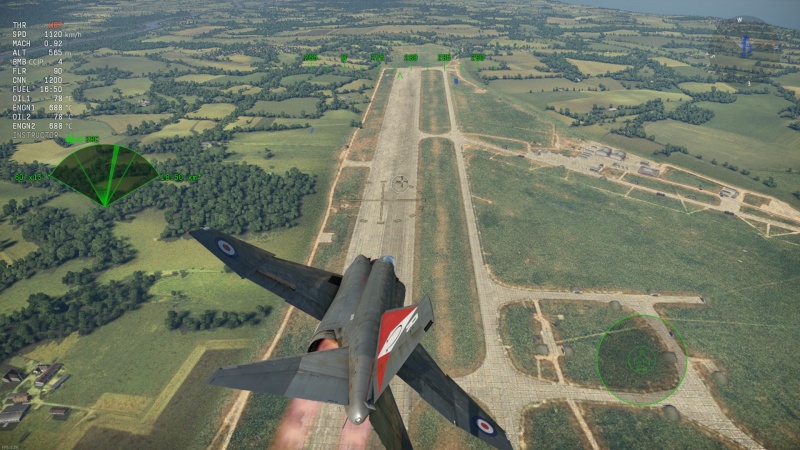
The bomb CCIP marker on a Phantom FG.1.

The bomb CCIP marker on a Ka-50.
Ballistic Computer Controls
All ballistic computer key binds are unbound by default, you must bind a key to them or use the Multi-function menu (not all controls are present in the multi-function menu).
| Ballistic Computer Controls | ||
|---|---|---|
| Control name | Default Keybind (PC keyboard & mouse) | Description |
| Toggle Ballistic Computer | Unbound | Toggles the ballistic computer functionality on or off. |
| Activate target point | Unbound | Places the target point where the player's reticle is pointing |
| Deactivate target point | Unbound | Removes any previously placed target point |
| Switch mission bombing target | Unbound | Automatically places the target point on a bombing point (mini-base or airfield). Press multiple times to select different bases. |
Читайте также:


